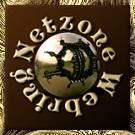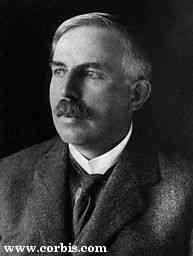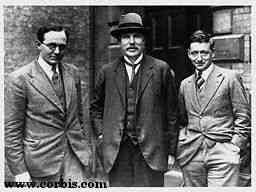![]()
Coasts
Rivers/Lakes
Lowlands/Plains
Geysers/Mud
Glaciers
Mt. Ruapehu
Mt. Cook
White Island
A Maori Legend
![]()
Abbotsford
Aramoana
Ballantynes
Brynderwyns
Cave Creek
Hawkes Bay
H.M.S. Orpheus
Influenza
Mt. Erebus
Mt. Tarawera
Rainbow Warrior
Seacliff Hospital
Tangiwai
Wahine
![]()
Annie Aves
Ata-hoe
Daisy Basham
Jean Batten
Minnie Dean
Mabel Howard
Margaret Mahy
Kath Mansfield
Kate Sheppard
Kiri Te Kanawa
Catherine Tizard
Murray Ball
Charles Goldie
Edmund Hillary
Richard Pearse
Lord Rutherford
Charles Upham
![]()
NZ FAQ--Funny
NZ Links
Credits
"That's the last potato I'll ever dig!" --Ernest Rutherford upon hearing of his English research scholarship to Cavendish Laboratory. Ernest Rutherford was born in a small village near Nelson, on the 30th August 1871. He developed a great interest in science at a young age and was often engaged in experimenting with gadgets or making things. His mother was a school teacher who assisted Ernest and his eleven brothers and sisters in their schoolwork. He was a very successful student and won a scholarship to Nelson College by scoring 580 marks out of 600; this allowed him to go directly into the fifth form. He followed this up with a scholarship to the University of Canterbury, at that time called Canterbury College. While there his studies concentrated on mathematics and physics. It was here that he met Mary Newton whom he would marry some five years later. In 1895 he finally won a scholarship to undertake research overseas. As transport wasn't included in the deal he was forced to borrow the money for his fare to England. Rutherford left New Zealand at the age of twenty-three, a highly-educated man with three university degrees to his name, a BA, MA, and a BSc. At this time Britain had no cars, aeroplanes, television or radio. Telephones and lights were in use, but still extremely rare. Laboratories were generally dark places with little in the way of equipment. It was often necessary for Rutherford to create his own equipment when that which was needed wasn't available.
At the Cavendish Laboratory in Cambridge, Rutherford was one of the first foreign graduates to be admitted. He started experimenting with radio waves, and was able to increase the distance at which he could receive them from only 20 metres to over 800 metres. Others then took over this work, including the famed Marconi who is now known as the inventor of the radio. It was now he turned his attention to radioactivity, something which had only just been discovered. Rutherford's study in this area was to pave the way for the atomic age. He discovered that radioactive substances give off two kinds of particles, alpha particles which are positively charged, and beta particles, these are negatively charged. In 1898 he was appointed Professor of Physics at McGill University in Canada. Since the time of the Ancient Greeks it had been considered atoms were stable and unchangeable, but while working with a team of researchers studying radium Rutherford discovered this was untrue. It was, he found, the disintegration of atoms which caused radioactivity. It was these discoveries which earned him the title of, "Father of Nuclear Physics." Rutherford came back to New Zealand in 1900 to marry his fiancee, Mary Newton. During the time apart they had written regularly. Over their life togather they had one daughter, Eileen, and four grandchildren, all of whom went on to become either scientists, engineers or doctors. In 1907 Rutherford returned to Britain where he took up the position of head of physics at Manchester University. The next year he worked with German scientist Hans Geiger to develop the first particle counter. Used for testing radioactivity this later became known as the 'Geiger Counter'. Geiger is quoted as saying Rutherford was, "counting particles like a miser counting his gold." Two years later Ernest Marsden, another scientist, joined up with the pair and they all worked on the scattering of alpha particles. Ernest Rutherford remains the only New Zealander ever to have won a Nobel Prize. This was awarded in 1908 for his work on the, "disintegration of elements and the chemistry of radioactive matters." Interestingly, he won the Nobel prize for chemistry, even though he was much better known for his work in physics.
When World War I broke out Rutherford turned his skills towards helping his country. German submarines were sinking many ships and in 1917 Rutherford perfected a hydrophone to detect them. It sent out sound waves and picked up echoes when they were bounced back by the hulls of enemy subs. As the war drew to an end Rutherford turned his attention back to atomic research. In 1918, he was able to convert nitrogen atoms into oxygen atoms by bombarding nitrogen gas with alpha particles. This was the first time anyone had succeeded in converting one element into another. Rutherford was appointed head of the Cavendish Laboratory in 1919. His time was now spent helping students with their projects though he assisted in the development of the proton accelerator in 1932. Two of the group of men working on this project were awarded Nobel Prizes for their work, two other discovered the neutron. On the 19th October, 1937, Rutherford was admitted to hospital for a minor operation. When complications set in doctors were unable to save his life. This came as a huge shock to his family as he had always been very healthy. His ashes were interred in Westminster Abbey, not far from the tomb of Sir Isaac Newton. Ernest Rutherford was well-aware of the potential in his discoveries though he did not believe he would see the power tapped in his lifetime. He also hoped that when it was, this would be for peaceful means only. In his lifetime Ernest Rutherford was accorded honours from many organisations around the world, including honorary doctorates from twenty-one universities, a Knighthood, and a Peerage. He has appeared on stamps in four countries: New Zealand, Sweden, Russia and Canada.
|



